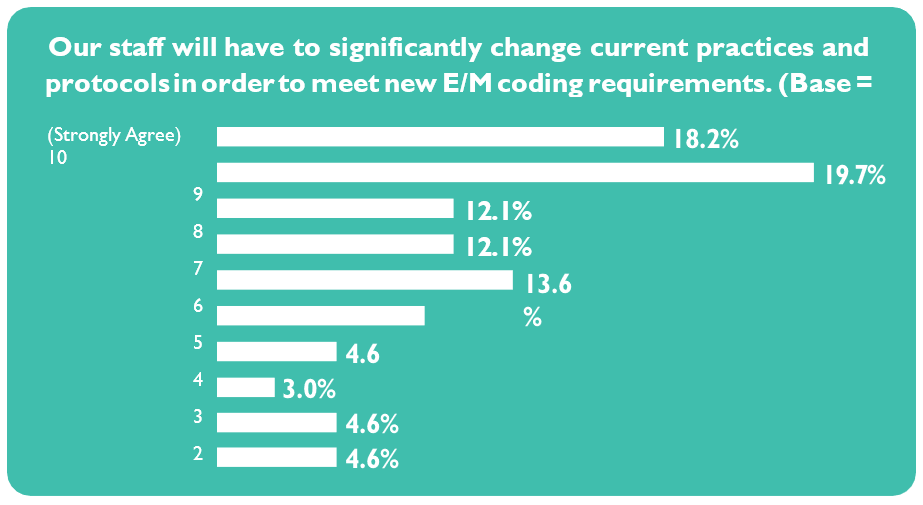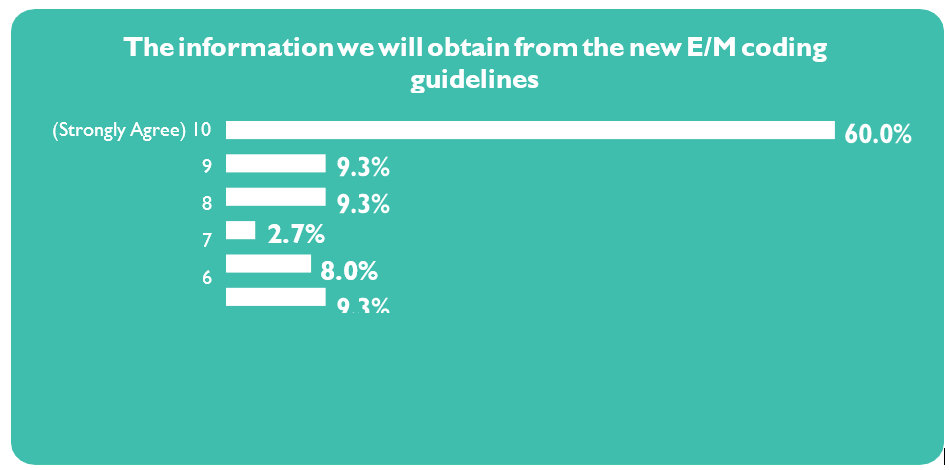

April 7, 2021
April 7, 2021
People at the top of healthcare organizations concur—COVID-19 is the biggest problem they have ever seen in their careers. This was the majority opinion of over 100 surveyed hospital leaders when asked to reflect on how the pandemic has impacted their organizations and their ability to prepare for changes ahead, including the January 2021 changes to the Evaluation and Management (E/M) coding guidelines.
Together, HealthStream and nThrive recently surveyed 127 hospital leaders about the upcoming changes to E/M coding guidelines, their organizational readiness for the transition, and relevant organizational challenges. Most (87.8%) surveyed participants (N = 66) agreed that, “the pandemic is having a major impact on our organization,” and more than half (62.1%) stated they “strongly agreed” with that statement. Results from this HealthStream survey offer a peek into the readiness of organizations for upcoming changes that arrived in January 2021. Four takeaway items from the survey address implementation prioritization, organization preparedness, the completion of AMA checklist activities, and the impending impact of new guidelines. Here are the final two points:
Despite self-reporting organizational readiness to implement the new guidelines, organizations still have work to do in order to complete the tasks suggested by the AMA in preparation of the upcoming changes.
The American Medical Association (AMA) put together a suggested checklist of activities for organizations preparing to implement the new E/M coding guidelines. Survey participants were asked to rate the level of implementation that has occurred at their organizations by reporting where they are in the preparation process, if they do not intend to implement, or have not started implementation, partially implemented, fully implemented, or don’t know. Note that a total of 69 individuals provided responses for this section.
The activity that has been most fully implemented by participants was “identifying a clear project leader to oversee the implementation of the new codes,” with some 34.8% of participants reporting full implementation. The least implemented activity was “understanding additional employer, payor or medical liability coverage requirements,” with 38.7% reporting they have not started implementing this activity.
The following tables separately demonstrate those activities with 50% or more partial or full implementation and those activities with 50% or more reporting they do not intend to implement or have not begun implementation of that item. The bolded numbers represent the highest reported percentage for each item.
Those activities with more than 50% reporting have either partially or fully implemented that step:
|
|
Don’t Intend to Implement |
Have Not Started Implementation |
Partially Implemented |
Fully Implemented |
Don’t Know |
|
Identifying a clear project leader to oversee the implementation of the new codes |
1.5% |
24.6% |
27.5% |
34.8% |
11.6% |
|
Updating practice protocols to be consistent with the new E/M coding requirements |
1.5% |
39.1% |
44.9% |
7.3% |
7.3% |
|
Determining how the actual training will occur in your organization |
0.0% |
29.0% |
52.2% |
8.7% |
10.1% |
|
Taking steps to guard against fraud and abuse law infractions |
0.0% |
31.9% |
37.7% |
17.4% |
13.0% |
|
Making sure the new protocols and procedures remain consistent with your organization’s compliance plan |
0.0% |
29.0% |
40.6% |
21.7% |
8.7% |
|
Coordinating the E/M changes with your electronic health record (EHR) vendor |
4.4% |
33.3% |
37.7% |
17.4% |
7.3% |
Those activities with less than 50% reporting have either partially or fully implemented that step, suggesting 50% or more either do not intend to implement the activity or have not yet started implementation:
|
|
Don’t Intend to Implement |
Have Not Started Implementation |
Partially Implemented |
Fully Implemented |
Don’t Know |
|
Scheduling a series of sessions to walk through upcoming changes with your providers |
0.0% |
37.7% |
34.8% |
14.5% |
13.0% |
|
Determining which outside vendors and resources will be needed to conduct training on the new E/M coding |
18.8% |
31.9% |
17.4% |
23.2% |
8.7% |
|
Considering the implications of the new coding in terms of medical malpractice liability |
4.4% |
37.7% |
27.5% |
7.3% |
23.2% |
|
Assessing the financial impact of using the new E/M codes |
2.9% |
37.7% |
36.2% |
11.6% |
11.6% |
|
Understanding additional employer or payor or medical liability coverage requirements |
4.4% |
39.7% |
27.9% |
8.8% |
19.1% |
Though the upcoming transition will require a lot of internal adjustments, most (89.3%) survey participants (N = 76) agree that the information obtained from the new E/M coding guidelines will be beneficial to their organizations.
Again, respondents were asked to rate a series of statements on a scale of 1-10 based on whether they agree or disagree with the statement. When asked to reflect on the changes that must occur, more than two-thirds (69.0%) of participants suggested their staff will need to change current practices and protocols in order to meet the new requirements:

The statement with the highest average (8.8) was, “the information we will obtain from the new E/M coding guidelines will be beneficial to our organization,” with some 89.3% agreeing. Nearly seven in ten (69.3%) strongly agreed that these new guidelines will be beneficial:

Although these changes require significant effort during an already difficult time, there is hope that 2021 will not only bring relief from the COVID-19 pandemic, but also that a long-awaited shift in E/M coding will eliminate unnecessary documentation burdens on physicians.
This article is the second of two excerpts from the HealthStream article, “New HealthStream Survey Results: 4 Things to Know About Upcoming E/M Coding Changes.” Download the full article by Susan Gurzynski-Wells, Senior Product Manager, Revenue Cycle, HealthStream, here.
COURSEWORK FOR E/M CODERS
Partnering with nThrive, HealthStream offers educational and training materials around E/M coding changes. For more information on how HealthStream can help with your coding needs and other revenue cycle challenges, click here.

.png?sfvrsn=3028f62b_0)